
Each of these historic structures tells a unique story, standing as a testament to Indiana’s rural past and the craftsmanship of early bridge builders. Photo Credits: CoveredBridges.com
As we look forward to the upcoming Parke County Covered Bridge Festival, it’s important to remember the rich history of the 31 active covered bridges that have earned Parke County the title of “The Covered Bridge Capital of the World.” Each of these historic structures tells a unique story, standing as a testament to Indiana’s rural past and the craftsmanship of early bridge builders.
A special thanks to coveredbridges.com for providing detailed, up-to-date information on these historic structures. To learn more about each of these bridges and to find the best routes for exploring them during the Parke County Covered Bridge Festival, visit coveredbridges.com. It’s a perfect resource for planning your journey through Indiana’s picturesque covered bridges.

The Beeson Covered Bridge, originally built in 1906 and relocated in 1979, was moved by Buchta Trucking to Williams Creek, after standing northwest of Marshall. It now resides in Billie Creek Village, adding charm to this historical attraction.
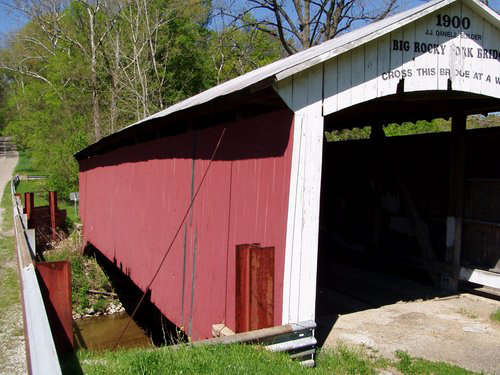
The Big Rocky Fork Covered Bridge, constructed in 1900 by Joseph J. Daniels, spans Big Rocky Fork near Fallen Rock Park, southeast of Mansfield. This bridge reflects the timeless beauty of Parke County’s scenic landscapes.

Built in 1895, the Billie Creek Covered Bridge is another of Joseph J. Daniels’ creations. It crosses Williams Creek and is located in Billie Creek Village, east of Rockville, offering visitors a glimpse into the area’s rich history.

The Bowsher Ford Covered Bridge, completed in 1915, was the work of builder Eugene Britton and contractor Elmer Garrard. It stands northwest of Tangier, crossing the (Wabash) Mill Creek.

One of the most iconic bridges, the Bridgeton Covered Bridge, was rebuilt by Dan Collom and the local community in 2006, after it was burned down by arson in 2005. This bridge spans Big Raccoon Creek and serves as the heart of Bridgeton, Indiana.

The Catlin Covered Bridge, originally built in 1907 and relocated in 1961, now resides on the north side of Catlin, near the Rockville Golf Course. Moved by Garrard Brothers Trucking, it’s a stop on the festival’s “Blue Route.”
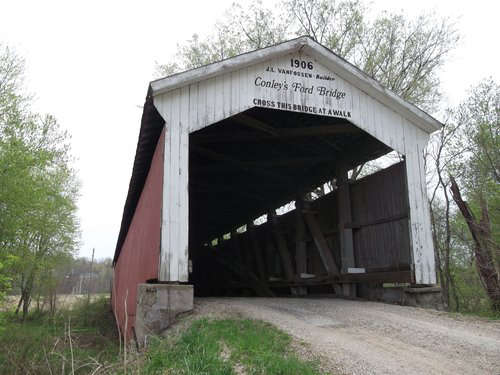
The Conley’s Ford Covered Bridge, dating back to 1906-1907, spans Big Raccoon Creek between Mansfield and Bridgeton. It is a serene reminder of the county’s agricultural heritage.

Constructed in 1913, the Cox Ford Covered Bridge is a notable bridge that crosses Sugar Creek. It is located near Turkey Run State Park, east of US 41.
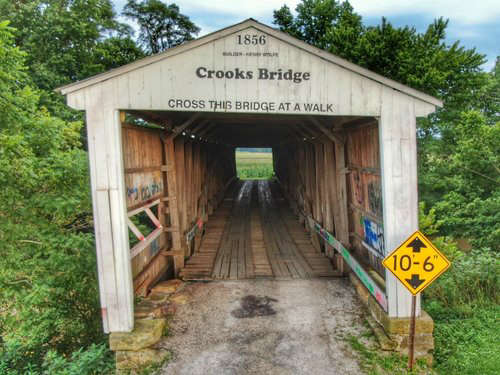
The Crooks Covered Bridge was built in 1856 or 1860 and rebuilt and moved in the 1860s by Henry Wolf. It now spans Little Raccoon Creek southeast of Rockville, part of the “Red Route.”

The Harry Evans Covered Bridge, built by Joseph A. Britton in 1908, crosses Rock Run northwest of Coxville. Its sturdy design reflects the expertise of its builder.

One of the county’s oldest bridges, the Jackson Covered Bridge, built in 1861, spans Sugar Creek near Annapolis and the forgotten town of Rockport. It is also featured on the “Blue Route.”
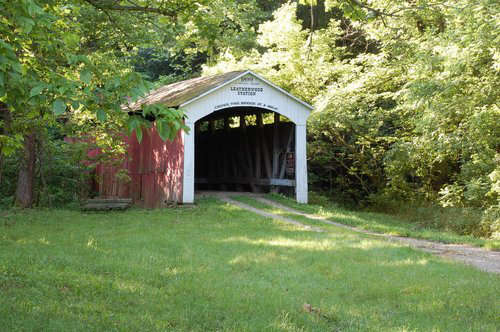
The Leatherwood Station Covered Bridge, originally constructed in 1899 and moved in 1981, now resides in Billie Creek Village. This bridge has been preserved thanks to the efforts of Elmer Buchta and stands as a tribute to the past.
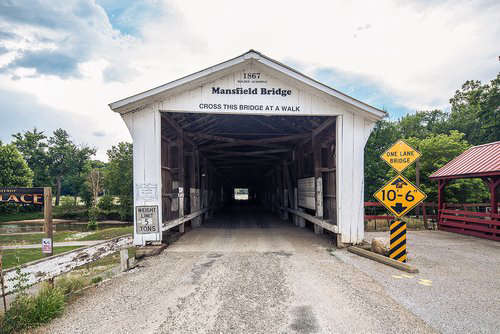
The Mansfield Covered Bridge, built in 1867 by Joseph J. Daniels, stands proudly near the Mansfield Mill. Its picturesque setting makes it a popular destination during the festival.
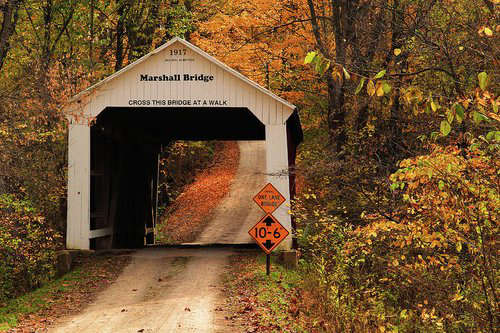
The Marshall Covered Bridge, built in 1917, crosses Rush Creek southwest of Tangier, showcasing the timeless design of Joseph A. Britton.

The McAllister Covered Bridge, built in 1914, spans Little Raccoon Creek southeast of Rockville. It is also featured on the “Red Route,” adding to the historical significance of the area.

The Mecca Covered Bridge, constructed in 1873, crosses Big Raccoon Creek in Mecca. This bridge is a highlight of the festival’s “Brown Route.”

The Melcher Covered Bridge, built in 1896 by Joseph J. Daniels, spans Leatherwood Creek near Montezuma, offering a serene retreat from the hustle and bustle of modern life.

The Mill Creek Covered Bridge, built in 1907, crosses (Wabash) Mill Creek southwest of Tangier. Its historic charm remains intact after more than a century.

The Narrows Covered Bridge, built in 1882, is a notable bridge located next to the Lusk Mill site in Turkey Run State Park, crossing Sugar Creek.

The Neet Covered Bridge, built in 1904 by Joseph J. Daniels, spans Little Raccoon Creek southeast of Rockville and is a key stop on the “Red Route.”

The Nevins Covered Bridge, constructed in 1920, crosses Little Raccoon Creek southeast of Catlin, reflecting the craftsmanship of Joseph A. Britton & Son.
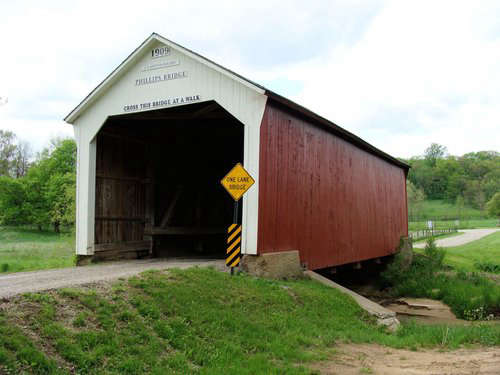
Built in 1909, the Phillips Covered Bridge spans Big Pond Creek west of Rockville, offering a peaceful spot for reflection.

The Portland Mills Covered Bridge, built in 1856 and moved in the 1960s, once crossed Big Raccoon Creek. It was relocated to its current position near Lake Mansfield.

The Roseville Covered Bridge, built in 1910, crosses Big Raccoon Creek in Roseville, a town with deep roots in the area’s history.

The Rush Creek Covered Bridge, built in 1904, spans Rush Creek south of Tangier. Its simple beauty adds to the county’s charm.

The Sim Smith Covered Bridge, built in 1883 by Joseph A. Britton, crosses Leatherwood Creek southeast of Montezuma, preserving a piece of Parke County’s rural history.

The State Sanatorium Covered Bridge, built in 1913, crosses Little Raccoon Creek on the grounds of the State Sanatorium, an eerie yet peaceful remnant of the past.

The Thorpe Ford Covered Bridge, built in 1912, crosses Big Raccoon Creek northwest of Rosedale, standing as a reminder of the area’s industrial heritage.
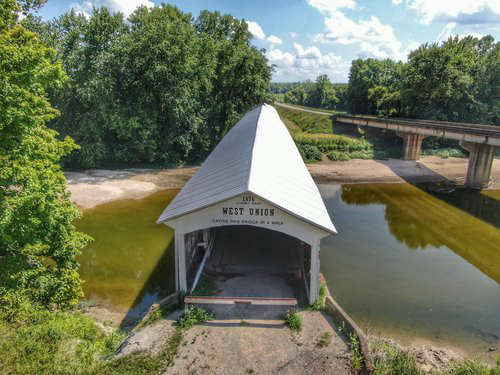
The West Union Covered Bridge, built in 1876, spans Sugar Creek near West Union, one of the oldest and most historic covered bridges in the county.

The Wilkins Mill Covered Bridge, built in 1906, crosses the dry bed of Sugar Mill Creek near Turkey Run State Park, offering a serene, wooded backdrop for visitors.

Finally, the Zacke Cox Covered Bridge, built in 1908, crosses Rock Run near Bradfield Station and remains a quiet testament to Joseph A. Britton’s bridge-building legacy.


 Reminder of the dangers of flood waters
Reminder of the dangers of flood waters
 Indiana State Parks hiring for lifeguards at public pools and beaches
Indiana State Parks hiring for lifeguards at public pools and beaches
 IDVA offers grant opportunities for non-profit organizations serving the Indiana Veteran Community
IDVA offers grant opportunities for non-profit organizations serving the Indiana Veteran Community
 Parke County man arrested on battery, strangulation charges
Parke County man arrested on battery, strangulation charges
 Gov. Braun activates Indiana National Guard to aid in storm recovery
Gov. Braun activates Indiana National Guard to aid in storm recovery
 INDOT prepared for severe weather, widespread flooding through weekend
INDOT prepared for severe weather, widespread flooding through weekend
 Legislation to provide FFA, 4-H students with excused school absences heads to governor
Legislation to provide FFA, 4-H students with excused school absences heads to governor
 USPS calls for customers to help prevent letter carrier dog bites
USPS calls for customers to help prevent letter carrier dog bites
 Attorney General says GM sold Hoosier drivers on using OnStar - then sold their data to raise rates
Attorney General says GM sold Hoosier drivers on using OnStar - then sold their data to raise rates
 Independent pharmacists urge lawmakers to adopt PBM bill
Independent pharmacists urge lawmakers to adopt PBM bill
 Single-lane closures to impact two U.S. 136 bridges near Crawfordsville
Single-lane closures to impact two U.S. 136 bridges near Crawfordsville
 Traffic pattern shift, ramp closure to impact State Road 63, I-74 in Vermillion County
Traffic pattern shift, ramp closure to impact State Road 63, I-74 in Vermillion County
 Single-lane closures to impact State Road 63 northbound near Cayuga
Single-lane closures to impact State Road 63 northbound near Cayuga
 PHHS National Honor Society inducts new members
PHHS National Honor Society inducts new members
 Financial aid available to schools to visit Indiana's state parks
Financial aid available to schools to visit Indiana's state parks
 Indiana celebrates Legacy Businesses, accepting nominations for Century, Half Century awards
Indiana celebrates Legacy Businesses, accepting nominations for Century, Half Century awards
 Former Indiana Governor Holcomb joins Doral Renewables board of directors
Former Indiana Governor Holcomb joins Doral Renewables board of directors
 Braun signs agricultural portal bill into law
Braun signs agricultural portal bill into law
 Trailer stolen in 2022 recovered in Parke County
Trailer stolen in 2022 recovered in Parke County




